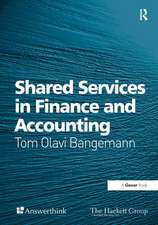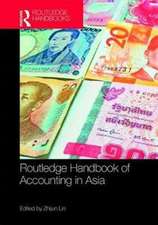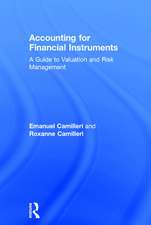Cash Flow Reporting (RLE Accounting): A Recent History of an Accounting Practice: Routledge Library Editions: Accounting
Editat de Thomas Leeen Limba Engleză Paperback – 26 noi 2015
| Toate formatele și edițiile | Preț | Express |
|---|---|---|
| Paperback (1) | 416.22 lei 6-8 săpt. | |
| Taylor & Francis – 26 noi 2015 | 416.22 lei 6-8 săpt. | |
| Hardback (1) | 986.91 lei 6-8 săpt. | |
| Taylor & Francis – noi 2013 | 986.91 lei 6-8 săpt. |
Din seria Routledge Library Editions: Accounting
-
 Preț: 341.55 lei
Preț: 341.55 lei - 34%
 Preț: 767.07 lei
Preț: 767.07 lei - 34%
 Preț: 708.55 lei
Preț: 708.55 lei - 34%
 Preț: 819.90 lei
Preț: 819.90 lei - 38%
 Preț: 764.20 lei
Preț: 764.20 lei - 34%
 Preț: 767.88 lei
Preț: 767.88 lei - 34%
 Preț: 764.20 lei
Preț: 764.20 lei - 34%
 Preț: 986.91 lei
Preț: 986.91 lei - 33%
 Preț: 1056.03 lei
Preț: 1056.03 lei - 34%
 Preț: 986.91 lei
Preț: 986.91 lei - 35%
 Preț: 1053.97 lei
Preț: 1053.97 lei - 34%
 Preț: 819.90 lei
Preț: 819.90 lei - 34%
 Preț: 524.78 lei
Preț: 524.78 lei - 36%
 Preț: 1589.81 lei
Preț: 1589.81 lei - 34%
 Preț: 767.88 lei
Preț: 767.88 lei - 33%
 Preț: 489.05 lei
Preț: 489.05 lei - 36%
 Preț: 986.91 lei
Preț: 986.91 lei - 33%
 Preț: 532.52 lei
Preț: 532.52 lei - 34%
 Preț: 485.78 lei
Preț: 485.78 lei - 34%
 Preț: 524.78 lei
Preț: 524.78 lei - 38%
 Preț: 773.18 lei
Preț: 773.18 lei - 34%
 Preț: 767.47 lei
Preț: 767.47 lei - 54%
 Preț: 513.61 lei
Preț: 513.61 lei - 34%
 Preț: 524.78 lei
Preț: 524.78 lei - 34%
 Preț: 986.91 lei
Preț: 986.91 lei - 34%
 Preț: 485.78 lei
Preț: 485.78 lei - 34%
 Preț: 769.92 lei
Preț: 769.92 lei - 34%
 Preț: 524.78 lei
Preț: 524.78 lei - 34%
 Preț: 1098.21 lei
Preț: 1098.21 lei - 54%
 Preț: 418.46 lei
Preț: 418.46 lei - 33%
 Preț: 770.31 lei
Preț: 770.31 lei - 34%
 Preț: 626.65 lei
Preț: 626.65 lei - 36%
 Preț: 626.26 lei
Preț: 626.26 lei - 34%
 Preț: 485.78 lei
Preț: 485.78 lei - 33%
 Preț: 742.91 lei
Preț: 742.91 lei - 34%
 Preț: 819.90 lei
Preț: 819.90 lei - 34%
 Preț: 826.84 lei
Preț: 826.84 lei - 34%
 Preț: 597.20 lei
Preț: 597.20 lei - 34%
 Preț: 819.90 lei
Preț: 819.90 lei - 34%
 Preț: 625.44 lei
Preț: 625.44 lei - 55%
 Preț: 541.50 lei
Preț: 541.50 lei - 34%
 Preț: 847.73 lei
Preț: 847.73 lei - 34%
 Preț: 1591.43 lei
Preț: 1591.43 lei - 34%
 Preț: 819.90 lei
Preț: 819.90 lei - 34%
 Preț: 25064.15 lei
Preț: 25064.15 lei - 21%
 Preț: 348.76 lei
Preț: 348.76 lei - 25%
 Preț: 241.15 lei
Preț: 241.15 lei - 34%
 Preț: 819.90 lei
Preț: 819.90 lei
Preț: 416.22 lei
Nou
Puncte Express: 624
Preț estimativ în valută:
79.64€ • 83.36$ • 66.29£
79.64€ • 83.36$ • 66.29£
Carte tipărită la comandă
Livrare economică 31 martie-14 aprilie
Preluare comenzi: 021 569.72.76
Specificații
ISBN-13: 9781138969919
ISBN-10: 1138969915
Pagini: 420
Dimensiuni: 174 x 246 x 22 mm
Greutate: 0.45 kg
Ediția:1
Editura: Taylor & Francis
Colecția Routledge
Seria Routledge Library Editions: Accounting
Locul publicării:Oxford, United Kingdom
ISBN-10: 1138969915
Pagini: 420
Dimensiuni: 174 x 246 x 22 mm
Greutate: 0.45 kg
Ediția:1
Editura: Taylor & Francis
Colecția Routledge
Seria Routledge Library Editions: Accounting
Locul publicării:Oxford, United Kingdom
Public țintă
General, Postgraduate, Professional, and UndergraduateCuprins
Preface. Acknowledgements. Dedication. Part 1: An Historical Review of Cash Flow Accounting 1. Cash flow Accounting and Corporate Financial Reporting 2. Cash Flow Reporting’s Recent History: a Kuhnian Interpretation of a Changing Accounting Emphasis. Suggested Additional Readings Part 2: Anomaly Recognition, Insecurity and Initial Responses 4. Introduction 5. Cash-flowitis: malady or Syndrome? 6. Present Discontents 7. Can We Define Generally Accepted Accounting Principles? 8. Establishing Accounting Principles 9. Suggested Additional Readings Part 3: Initial and Extended Cash Flow Reporting Arguments 10. An Introduction 11. Cash Flow Statements for Investors 12. Let’s Scrap the ‘Funds’ Statement 13. Cash flow Accounting 14. The Rationale of Cash Flow Accounting 15. A Case for Cash Flow Reporting 16. Reporting Cash Flows and Net Realisable Values 17. Suggested Additional Readings Part 4: Demonstrating the Utility of Cash Flow Reporting 18. An Introduction 19. Cash Flows, Exit Prices and British Airways 20. The nature and Amount of Information in Cash Flows and Accruals and 21. The Information Content of Cash Flow Figures J22. Using Operating cash Flow Data to Predict financial Distress: Some Extensions 23. Cash Flows, Ratio Analysis and the W. T. Grant Bankruptcy 24. The Cash Flow Performance of UK Companies 25. Funds Statements and Cash Flow Analysis 26. The Incremental Information Content of the Accruals and Funds Components of Earnings After Controlling for Earnings 27. Suggested Additional Readings Part 5: Debating the Utility of Cash Flow Reporting 28. An Introduction 29. Cash Flow Accounting: A Review and Critique 30. In Defence of Profit Measurement: Some Limitations of Cash Flow and Value Added as Performance Measures for External Reporting 31. The Interpretation of Cash Flow Reports and the Other Allocation Problem 32. Cash Flow Accounting and Liquidity: Cash Flow Potential and Wealth 33. Suggested Additional Readings Part 6: Influencing Accounting Policy-Making 34. An Introduction 35. Cash Flow Statements 36. Statement of Cash Flows 37. Cash Flow Accounting 38. Making Corporate Reports Valuable 39. Suggested Additional Readings
Notă biografică
Multivolume collection by leading authors in the field
Descriere
This collection explores Kuhn’s 1970 perception of a scientific revolution in the form of a cyclical sequence of anomaly recognition; insecurity, alternative ideas, schools of thought and dominating practices. Cash flow reporting has become a dominant accounting practice which emerged from a developmental process of Kuhnian form. The text is constructed around the various stages identified by Kuhn and selected readings are categorised accordingly.






















